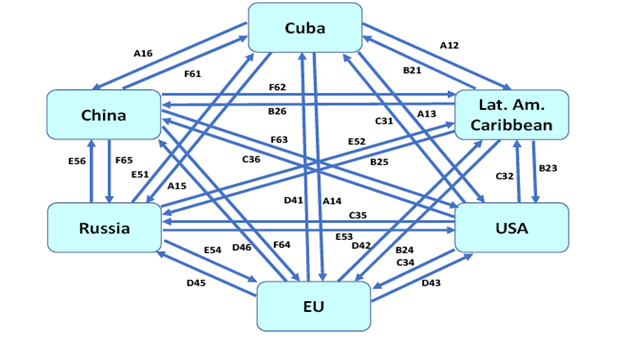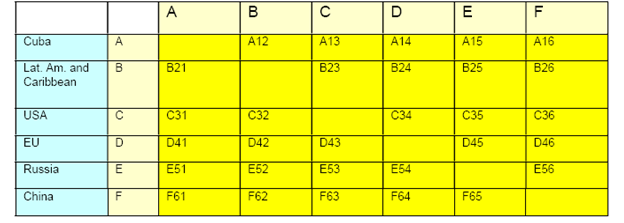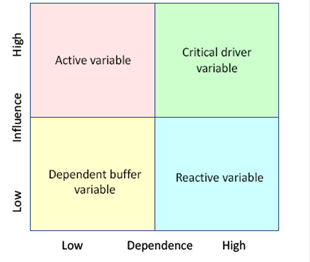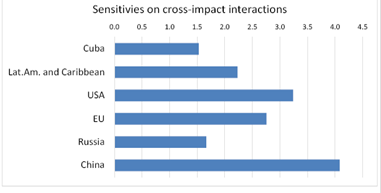Introduction
This paper focuses on Cuba and its position in the world by means of geopolitics and geoeconomics. These two concepts are used to describe the current international political dimensions and how different nations attempt to control their position within global power politics. Geopolitics is not a new phenomenon. The official term “geopolitics” was first used by Rudolf Kjellén in1899 [1]. Cowen & Smith [2], posed the idea that geopolitics played a role in nation-building in Europe as early as in the 19th century. Geopolitics as a concept has gone through many different stages throughout history and thus its past can be viewed as controversial. Its roots lie in European imperialism but geopolitics has emerged all over the world in different political contexts. David Livingstone [3], highlighted the plurality of geopolitics and concluded that there is no singular geopolitical tradition. According to him, it is important to recognize the different geopolitical variants that have be enconstructed in different places and time periods.
Geopolitics has always been related to energy economy and energy policy whether it can be consideredrenewable or none renewable energy. Energy geopolitics has primarily centred around fossil fuelsthroughout history due to their wide usage. Scholten [4], specified that oil, coal and natural gas were themost used energy resources in the world in 2014, making up 86% of the entire energy mix. Renewableenergy sources covered only a small proportion of the world’s energy usage. Trend analyses indicate thatelectricity production and consumption developments are in the transition process in China, in the USAand European Union. These regions are major players in global climate change and climate policy.Especially China is now a global trendsetter in climate change and climate policy. Upwards slopingtrends were evident in the Chinese energy economy. However, the U.S. and the EU are still veryimportant players.
The structures of electricity production and energy mixes are changing. Globalbenchmarking studies indicate that the role of renewables is increasing in electricity production and therole of oil-based electricity production has drastically decreased.Cuba has throughout history been heavily connected to the states located in its neighbourhood as well asthe international power politics. The country was colonized by Spain in the 16th century and continued tobe under the control of the United States (US) after the war between the US and the Spaniards in 1898. Cuba gained its independence a few years later in 1902. The US was still heavily involved in thecountry’s business which resulted in The Revolution in 1959, led by Fidel Castro. After the Revolution,the country formed a socialist state that was and still is led by the Cuban Communist Party as a singleparty. The country had strong connections to the Soviet Union (USSR) during the Cold War period.
Astensions rose between the US and the USSR, Cuba became the centre of attention in the Cuban missilecrisis in 1962. After the crisis, Cuba continued its business with the Soviet Union but the relationship wasnot going to last. In 1991, the Soviet Union collapsed which meant that the country’s primary companionwas no longer able to support them. This was a big setback to the Cuban economy and the country’seconomy fell into recession. Cuba has since found new partners in Spain, Venezuela, China and otherLatin American countries but the cooperation with Russia still continues. Cuba’s relationship with the UShas remained less than friendly throughout the years. The US has, for example, attempted to overthrowthe country’s socialist government, assassinate the president several times and still maintains the embargoit placed on Cuba during the missile crisis in 1962.
During the Obama administration (2009-2014) therelationship between the two countries entered a new era and promises of lessening the embargo weremade. Obama administration also lifted some of the travelling restrictions to Cuba and allowed theCubans immigrants living in the US to send money to Cuba. All of this was reversed by the Trumpadministration between 2017 and 2021. The new Biden administration (2021-) has made little to nochanges to the situation.In this article, we illustrate the impacts of geopolitics and further explain the Cuban dependency oninternational global politics through Cross-Impact analysis (CIA).
Methodology
Cross-Impact analysis is an umbrella term for a variety of different cross-impact methods that can be usedto analyse events, as a tool for planning and to form several scenarios of different futures. In this method,modelling is formed and different variables are placed in it to display the relationships the variables havewith each other. Instead of empirical data or statistics, the key feature of the CIA is that it relies on dataharvested from experts in order to form its modelling. In this analyse, we are using the CIA calledExpress Cross-Impact Technique (EXIT) [5, 6, 7]. We form three different future scenarios that willexplain the changing relations of the different nation-states while keeping our focus on Cuba in particular.
Cuba has historically been in the middle of many big global events, notably for example during the ColdWar. Thus, it is interesting how the position of Cuba might change along with the changing powerpolitics. MIn our modelling, we have 6 different variables in form of six different state(s); A: Cuba, B: LatinAmerica & Caribbean, C: The United States, D: European Union, E: Russia and F: China. By changingthe relationships of these nations, we can examine how dependent they are on each other and howinfluential they are compared to each other. The impacts of the nations on each other are indicated in figure 1. For instance, the Cuban impact on Latin America and the Caribbean is marked with A12 whilethe Latin American impact on Cuba is indicated with B21 and Russia’s impact on the USA is indicated with E52. These direct impacts are collected in the Cross-Impact Matrix shown in table 1, where theimpacts of row variables on column variables are indicated.
Geopolitics through cross-impact analysis
An expert group defined the assumed changes of the direct impacts of the variables on each other in each scenario. The direct impacts are placed in the Cross-Impact matrix and the EXIT algorithm calculates the chained cross-impacts between the variables. The algorithm calculates all possible chains of impacts (such as A->B->D->E->F->B->A) and constructs new values for the impacts between the variables taking into account all these possible cross-impacts. These cross-impacts change the driver-driven values of the variables providing interesting information about the dynamics of the system.
The states were selected because a) they are very influential in global power politics or b) they are expected to be affecting Cuba in some way due to their location in the world. Each impact is given a number between -4 to 4 depending on the expected state’s ability to influence the other variables. For example, if the US is given a 4, it is expected that the impact of the state will increase considerably on the other variable, for instance, Cuba. And, if the US is given a -4, it is expected that the impact of the state is going to decrease considerably on the other variable, for instance, China. All of the variables are compared against each other and based on the overall score they get they are sorted into driver states and driven states. Driver states are the states that have the largest impacts on others in each scenario. Driven states on the other hand are impacted by other states. A state can be both a driver and driven if it is impacting others but is also impacted by others.
This type of state is a critical driver variable having both high influence and high dependence. If a state has high influence and low dependence it can be called an active variable. A state which has low influence and high dependence is called a reactive variable. And a state with low influence and low dependence is called the dependent buffer variable. The classification is illustrated in figure 2.
The three scenarios we have created are the Two Red Flags, the Pan American Renaissance and the Cold War II. The names of the scenarios reflect the nature of the narrative storylines of the scenarios.
In the Two Red Flags scenario, China and Russia will gain more influence in Latin America and the Caribbean. This could be due to the US backing away from the region and focusing its efforts somewhere else. China is already spreading its influence throughout the world and has caused the US to view it as a threat. It is a growing economy and the likelihood of its influence growing in the future is not unlikely.
Russia has been China’s long-time partner and has provided the country with resources such as raw materials and oil. So, the two countries act as allies in this scenario while China takes the role of the most influential actor. In this scenario, the US and Europe stay further away from Latin America and thus their influence diminishes. The larger China and Russia grow in this scenario, the less the EU and US are expected to influence the two opposite states. In this scenario, Latin America and Cuba will grow closer to the China/Russia unite and both sides will affect each other in some sense. It is expected that China/Russia will be able to influence Latin America and Cuba more than vice versa. Latin America and Cuba’s influence on the US and EU will be very neutral and the relationships will grow distant. The Cross-Impact Matrix of the direct impacts in the Two Red Flags scenario is shown in table 2.
The Two Red Flags scenario
Table 2 Cross-Impact Matrix of direct impacts in the Two Red Flags scenario. Assessment of the increase of the impact of the row variables on the column variables
| Scale: -4, -3, -2, -1, 0, +1, +2, +3, +4 | A | B | C | D | E | F |
| Cuba | 1 | -1 | 0 | 1 | 1 | |
| LatAm. and the Caribbean | 1 | -2 | 0 | 1 | 2 | |
| USA | -2 | -1 | -1 | -2 | -1 | |
| EU | 1 | 1 | 0 | -1 | 0 | |
| Russia | 2 | 1 | -2 | 2 | 2 | |
| China | 4 | 5 | 2 | 2 | 3 |
In this scenario, China is the clear driver state. The driven state is Cuba. The Latin American states, The US and Russia are all rather strong drivers and driven states. The EU on the other hand doesn’t appear to be a strong driver or driven state either. This setup will be the basis of the Cross-Impact Analysis.
After the Cross-Impact Analysis, we can predict the changing relationships of the different states. We will examine how influential the different variables are on each other and on the other hand how dependent they are on each other. The results are visualised in figure 3, below and the changes caused by cross-impacts in figure 4.
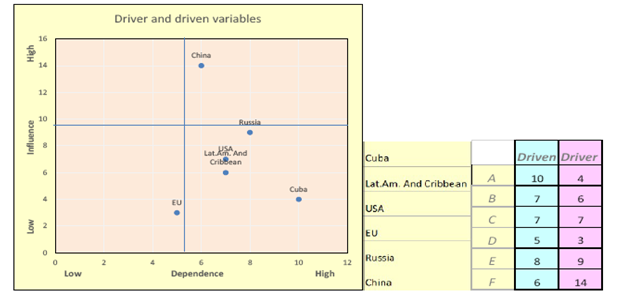
Fig. 3 Location of the states in the Influence-Dependence chart in the Two Red Flags scenario based on direct impacts
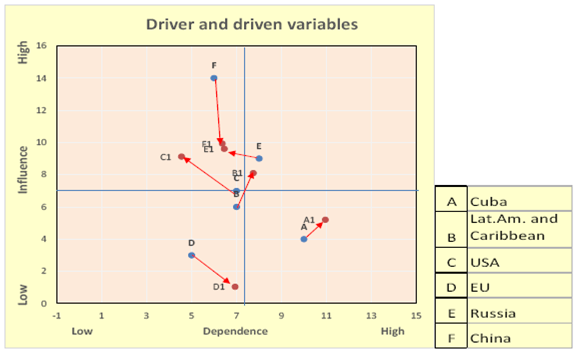
Fig.4 Changes in the Influence-Dependence of the states when the cross-impacts are taken into account in the Two Red Flags scenario
The table above illustrates the results of the Cross-Impact Analysis. We can see that China’s influence is getting smaller as a result of the cross-impacts while its dependence on other states remains largely the same. The opposite happens with Russia. Its influence does not grow by much but its dependence on other states is getting smaller. Although the change is not massive. The US gains a bit more influence and becomes less dependent on other states and the EU, in turn, loses influence while becoming even more dependent on other states. Finally, Cuba’s influence grows slightly while it becomes more dependent on other states. Figure 5, illustrates the sensitivities of the position of different countries on the cross-impacts. This shows the change of the position from the direct impacts when the cross-impacts are taken into account.
The reasons for the results above can be explained by the fact that the states that are very involved in global politics are both influential and somewhat independent from outside influences. However, the more they are involved with other states less influential than them, the relationship itself seems to lift upthe less influential states. They gain influence but in turn, become more dependent on others. This seemsto be the case with the Latin American countries and Cuba.
Countries like the US still hold a rather strong influence but by not involving themselves with other states the less dependent it will become. In the case of the EU it is not a strong driver or driven state, its influence diminishes and it grows more dependent.
The Pan American Renaissance
In this scenario, the US will change its foreign policy strategy and form connections to Cuba. It will also focus its efforts on the Latin American states and gain more influence in this way. Its alliance with the EU will also strengthen. In this scenario, China and Russia will take a back seat and pull their forces from Latin America. On the contrary to the previous scenario, this time the US and EU are the powerful global actors with the lead of the US. The Latin American countries and Cuba will also be able to influence the US and the EU through the alliance. China and Russia will likely continue their long-lasting relationship but on a smaller scale. Their influence on the other state is neutral or negative. See table 3.
Table 3 Cross-Impact Matrix of direct impacts in the Pan American Renaissance scenario
| Scale: -4, -3, -2, -1, 0, +1, +2, +3, +4 | A | B | C | D | E | F |
|---|---|---|---|---|---|---|
| Cuba | 2 | 2 | 1 | 0 | -1 | |
| LatAm. and the Caribbean | 2 | 3 | 2 | 0 | -2 | |
| USA | 4 | 3 | 2 | 0 | -1 | |
| EU | 2 | 1 | 2 | 0 | -1 | |
| Russia | -1 | -1 | 0 | -1 | 1 | |
| China | -1 | -1 | -1 | 0 | 1 |
In this scenario, the US is a clear driver state. Through the relationship with the US, the EU is able to gain more influence but is still rather dependent on other states. It is both a driver and driven state and not strong in either front. This is the case with almost all the variables in this scenario. Most of them are not clearly driver or driven states. Russia and China are the two that take the biggest hit in influence but remain largely independent. This can be seen in figure 6, below.
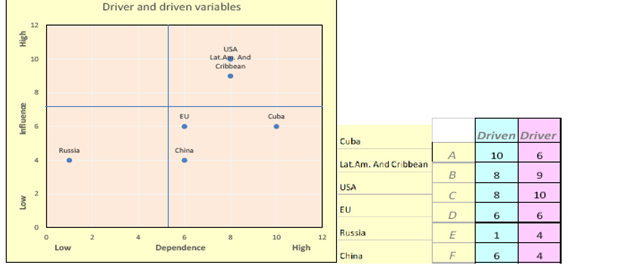
Fig. 6 Location of the states in the Influence-Dependence chart in the Two Red Flags scenario based on direct impacts
Figure 7, explains the changes in the relationships between the different states when the cross-impacts are taken into account. In this scenario, the changes are smaller than in the Two Red Flags. Similar trends can be noticed in this scenario, although they are not identical. The US has the highest influence but it diminishes the more it is involved with the other countries. The same can be noticed in the case of the Latin American states. EU’s influence grows as a result of the cooperation with the US. The same trend can be seen with Russia that in this scenario takes steps back in the global power politics. China gains little to no influence and grows more dependent on other countries. Cuba on the other hand grows slightly less dependent.
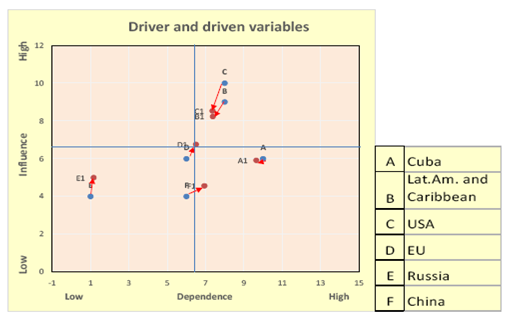
Fig. 7 Changes in the Influence-Dependence of the states when the cross-impacts are taken into account in the Pan American Renaissance scenario
The Cold War II
In the last scenario, the tensions start to rise between the different alliance groups. In this version, the US and EU have formed one alliance group against Russia and China. Cuba is linked to the China/Russia alliance while the Latin American states appear as rather neutral. The powerful states; the US, the EU, China and Russia will mainly focus on each other while the US and China will act as the main aggressors. Cuba still stays in contact with the Latin American states and viceversa. See table 4.
Table 4 Cross-Impact Matrix of direct impacts in the Cold War scenario
| Scale: -4, -3, -2, -1, 0, +1, +2, +3, +4 | A | B | C | D | E | F |
| Cuba | 1 | -1 | -1 | 1 | 1 | |
| LatAm. and the Caribbean | 1 | 0 | 0 | -1 | 0 | |
| USA | -4 | -2 | 2 | -3 | -4 | |
| EU | 0 | 0 | 2 | -1 | -1 | |
| Russia | 3 | 0 | -2 | -2 | 3 | |
| China | 4 | 2 | -4 | -2 | 4 |
In this scenario, China and the US are two very close driver states. Russia is equally a driver and a driven state while the EU continues to obtain less influence. Latin America stays out of the conflict so its dependence and influence are not high. Cuba continues to be a driven state, even more so than in the previous scenarios. Figure 8, illustrates the direct impacts of the Cold War scenario and figure 9, the changes caused by the cross-impacts.
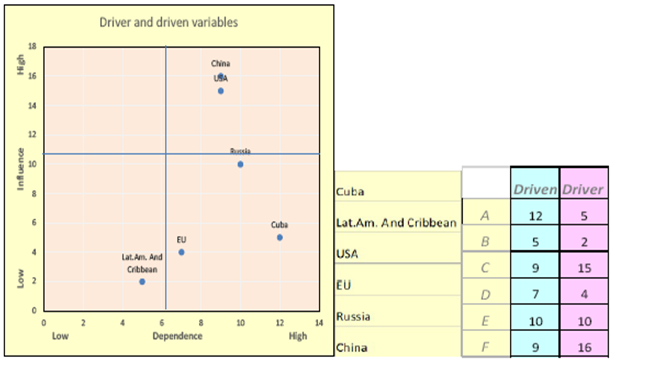
Fig.8 Location of the states in the Influence-Dependence chart in the Cold War scenario based on direct impacts
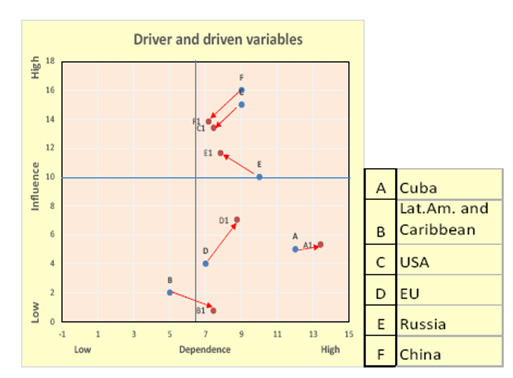
Fig.9 Changes in the Influence-Dependence of the states when the cross-impacts are taken into account in the Cold War scenario
Yet again, similar trends can be seen in the case of the strongest countries. Both China and the US lose their influence due to focusing on each other. Russia on the other hand gain influence and is less dependent on the other states. The EU will also appear as a more influential actor but will become more dependent. In both the case of Latin America and Cuba, their dependency increases.
General considerations on the case of cuba and conclusion
The Cross-Impact Analysis paints an interesting picture of global power politics. The strongest states in each scenario while influential and rather independent actors are never completely independent and tend to lose some of their influence as a result of the complex interactions and interdependencies. The possible reason for this could be that these states often try to either defend their position in global power politics or try to gain more power in relation to the other states. These states will often form alliances with other countries at least in some form. Due to these reasons, they always have to think about their possible opponents and alliances while forming their foreign policy. This makes them less independent and leaves room for other countries to influence them.
Countries that are still powerful but don’t take part in global power politics tend to gain more influence and are the most independent actors of the system. Some actors are heavily connected to the cooperation they have with other states so depending on how the cooperation is going, the more influence they gain and the more dependent they become. Smaller countries that are weaker actors in global power politics are automatically in a difficult spot.
They are not automatically influential and will have to rely heavily on alliances to influence other countries. And this leads them to become heavily dependent. This is also the case with Cuba. Figure 10, displays the three different scenarios and how Cuba’s influence and dependency change according to them. The changes are not major but they paint the picture of Cuba in the global power politics. There is no question about the fact that Cuba is a country that is heavily dependent on outside forces. In all three scenarios, Cuba’s dependency has always stayed high. There have been some changes in Cuba’s ability to influence other states but that has always resulted in the loosing of independence. The best scenario out of these three is the Pan American Renaissance. In that scenario, Cuba’s influence remains rather high while it grows less dependent. The dependence seems to grow both in the Cold War II and the Two Red Flags scenarios.
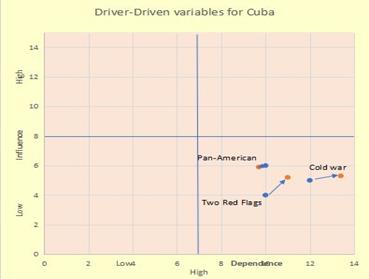
Fig. 10 Changes in the position of Cuba as a result of cross-impacts in the different scenarios on the Influence-Dependence chart
The Cuban position in global power politics supports the arguments that can be made through geoeconomics and dependency theory. Cuba has always been dependent on other states and their political movements in many political sectors. This is due to Cuba’s history, how the country has formed its own economy in the past, what kind of foreign policy decisions it has made and how the states close by and far away have reacted to its presence.
In this article, we explore the complex role Cuba plays in global power politics through geopolitics and geoeconomics as well as from the viewpoint of dependency. It is obvious that the current global climate presents a challenge to the Cuban state. Cuba is still heavily impacted by dependencies thus making it vulnerable. Dependence is a corollary of dominance, a situation in which a developing country has to rely on a developed country’s domestic and international economic policy to stimulate its own economic growth and development. The Cuban space for manoeuvrings is limited and makes the policy forming ever so important. The situation of the state is partly a result of its historical context with path dependencies. Cuban economic structure is still dependent on old production structures established in the past and there is a lot of potential for development. The source of dependency comes from a few export commodities as well as a few partnering countries. In the case of import commodities, the variability is greater and the number of partner countries is larger resulting in less dependency. However, dependencyon food and technology imports remains a significant challenge.
The US blockade creates major obstacles to Cuban development. This has given opportunities for other actors to strengthen their cooperation with Cuba. China has become a prominent actor in the region and has considerably increased its influence on the Cuban economy. The European Union has through its Political Dialogue and Cooperation Agreement (PDCA) pursued to develop a closer bond between the two actors. However, it is important to note that the dependencies have several different forms as illustrated by the cross-impact analysis. The results of the cross-impact analysis display the limitations of Cuban influence as well as the high dependency on the global actors.
The geopolitical and geoeconomic frameworks provide an intriguing approach to examining these power relations. A more comprehensive cross-impact analysis of this topical area can be found in [8]; further research will be published in the near future. Yet, a variety of possibilities still exist for Cuba. Balanced cooperation with the Caribbean countries and the European Union could, for example, provide new opportunities for mutually beneficial collaborations. These partners come crucial in developing, for instance, the already promising fields of biotechnological and pharmaceutical industries. Utilizing these opportunities takes careful planning and smart investments. To reach their full potential it is necessary to take into account the different interactions of the complex domestic and global political processes. Cuba is on its own, facing challenging trade-offs to harmonize social and economic objectives. Especially, maintaining progress in education, health, life expectancy and other social indicators while providing incentives for personal advance, entrepreneurial initiatives and improvements in productivity call for an extremely difficult political balancing act in Cuba.













